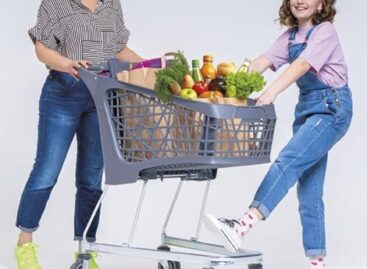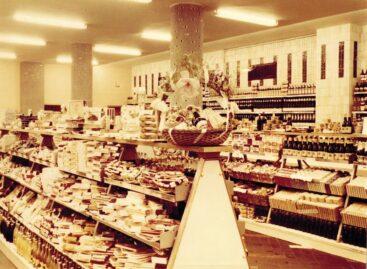The 2018 FMCG retailer ranking is out now
Trade magazin traditionally publishes its FMCG retailer ranking on the first workday in June. The good sales results of former years improved further last year. Discount supermarkets were very successful, to the extent that Lidl is now the No.4 retailer in Hungary, changing places with CBA. Although there was no change in the Top 3 and the same 11 retailers are featured in the ranking as last year, more retailers made their sales data public than ever before. Based on the data that they provided, we can say that 2018 was an exceptionally good year for FMCG retailers and every chain featured in the ranking increased sales in comparison with the previous year.

Hermann Zsuzsanna
Statistical data from the Central Statistical Office (KSH) show that retail trade’s contribution to the GDP is 10 percent year after year. Last year there were 500,000 people working in the sector. Retail sales increased by 6.6 percent and surpassed HUF 11,000 billion in value. From this sum the share of the FMCG market was 5,100 billion. The 5-percent sales growth of recent years continued.
Data from Nielsen indicate that the FMCG market expanded by 7.2 percent in value in 2018, which was a superb sales performance; taking a look at the food segment we can see that sales were up 7 percent, while sales of household chemicals and cosmetics jumped 8.1 percent.
GfK data show that the number of purchases didn’t change last year, so the sales growth was the result of shoppers spending more at buying occasions, which fact had to do with the 2.8-percent inflation rate and higher prices. As regards the various retail channels, it is noteworthy that 93 percent of the 4 million households visited discount supermarkets too, and this is the only channel that produced more shopping occasions than a year before.
Last year was our best
‘Last year was more successful than ever before in the FMCG market – and the retailer ranking shows this very well’ – told Zsuzsanna Hermann, editor-in-chief of Trade magazin. ‘Throughout the year we reported positive news about the sector, the product categories, the manufacturers and the retailers. All of these are summed up in the ranking now. It isn’t by accident that communication in the last 12 months was all about growing consumption; the consumer confidence index is still rather high, despite having dropped a point. As for the future, we are still optimistic, although perhaps a bit less than we were last year…’
Rising salaries – for some people several times last year – had an impact on the good sales results. However, the data also indicate that the number of shops is decreasing fast. Unfortunately the workforce shortage and growing salaries forced many small shops to go out of business last year.
It is true that those retailers that sent their data only know the exact number of their own stores and there are also shops connected loosely to them, but data is getting more accurate year after year, and we can see the trend that many of the low-efficiency, loss-making small shops are closed. This is what happened last year too and this trend is unlikely to stop. At the same time this also means that efficiency increases, and because everyone was talking positively about their results, even the small changes in the sales results indicate greater efficiency.
Discount supermarkets won and Lidl stepped one place up
The numbers indicate that discount supermarkets were the best-performing retail channel in 2018. There was only one change in the positions of retailers in the ranking in comparison with last year, and this was the result of discount supermarkets strengthening their positions: Lidl stepped a place up to No.4, overtaking CBA. It was also the first time that not only Lidl, but also Penny sent their sales data to us – we hope that next year Aldi will join them, too.
Just like in the year before last, drugstores kept on strengthening in 2018. Last year dm opened one and Rossmann opened 10 new drugstores, and consequently they saw their sales strengthen significantly; plus several existing drugstores were modernised and extended, and their product selection got bigger. Since those retailers can make it to the ranking that realise minimum gross sales of HUF 50 billion, it is quite sure that Müller will be on our list next year as the third drugstore chain.
It is really good news that Tesco was able to provide as with data on Hungary about 2017 – from their 4-country regional data – so last year’s sales results were easier to estimate with the help of experts. Hypermarkets haven’t been performing very well recently, but thanks to their size their sales results are still rather good. It must also be mentioned that many hypermarkets were converted or modernised, and this step will soon have its affect felt in sales. Good examples of this are SPAR and Auchan. SPAR was very successful in realising sales growth in other channel types, mainly via the expansion of its franchise network. Auchan appeared in a new channel by opening large supermarkets, plus their sales also increased with the help of having more filling stations.
Hungarian-owned retail chains lost many stores, but most of these weren’t their own, they were justly loosely connected to them. In the case of Reál this trend was clearly visible (and we aren’t only talking about the last 12 months here). The majority of these lost stores were low-turnover, not profitable businesses. COOP and CBA lost small floor space stores, too, but not as many as Reál.
The main thing is to have positive results
‘I hope that this year will be just as good sales-wise as 2018 was, and the consumption growth will continue, because rising salaries create the background for this. Still, we must also listen to those experts who are predicting a slowing down of the economy, so that our expectations won’t be too high and we will be happy about any sales result if it is positive. One year from now I will be ‘explaining’ the numbers from 2019 – hopefully with as much optimism as now’ – said the editor-in-chief of Trade magazin.
FMCG Retailer Ranking 2018_poster_final
Methodology:
Data contained in the ranking were provided by the retailers. When a retailer made no data available, Trade magazin’s estimate was used, which was based on the magazine’s 2017 retailer ranking, and on the 2017 and 2018 tax declarations of the companies, taking into consideration – with the help of experts – the changes in market conditions which have occurred since then.
For more information please visit our website www.trademagazin.hu our send us an email with your question to info@trademagazin.hu. We will publish the toplist in the next Trade magazin 2019/6 issue on 10th of June.
Related news
YouGov Shopper: market research on new grounds
🎧 Hallgasd a cikket: Lejátszás Szünet Folytatás Leállítás Nyelv: Auto…
Read more >Retail kept its position in terms of employer attractiveness
🎧 Hallgasd a cikket: Lejátszás Szünet Folytatás Leállítás Nyelv: Auto…
Read more >István Nagy: Hungarian melon season starts with good quality melons
🎧 Hallgasd a cikket: Lejátszás Szünet Folytatás Leállítás Nyelv: Auto…
Read more >Related news
Csemege: the taste and essence of an era
🎧 Hallgasd a cikket: Lejátszás Szünet Folytatás Leállítás Nyelv: Auto…
Read more >Danone to expand yogurt plant in Canada
🎧 Hallgasd a cikket: Lejátszás Szünet Folytatás Leállítás Nyelv: Auto…
Read more >Vegan scrambled eggs at 30,000 feet
🎧 Hallgasd a cikket: Lejátszás Szünet Folytatás Leállítás Nyelv: Auto…
Read more >






